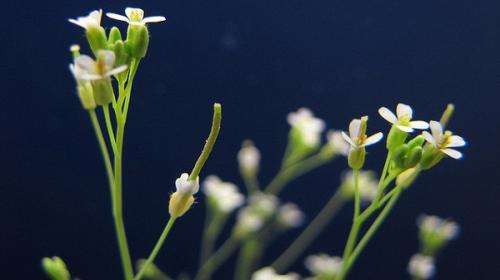Finding the signalling system for plant 'smoke' response

Research out of China and WA has shown chemicals promoting germination in native Australian plants have a powerful effect on other plants, such as rice.
"We have discovered that there is a fundamental signalling system in plants that was previously unknown," UWA plant scientist Steven Smith says.
"We've discovered a new system for the control of plant growth."
W/Prof Smith had been studying the effects of the karrikin—a chemical in bushfire smoke that stimulates germination—when he met Prof Jiayang Li who was conducting parallel research on another plant hormone group known as strigolactones.
In 2012 he invited Prof Smith to his lab at the Chinese Academy of Sciences in Beijing where they compared the activities of karrikins and strigolactones.
They then compiled a review of their own and other researchers' work. This included isolating mutants that no longer respond to karrikins. In the process they discovered the genes required for the response to the karrikins.
This showed the karrikin response system was closely related, and connected, to signalling for strigolactones.
"Our research tells us that there must be another hormone that we haven't yet discovered, and the Karrikin smoke compound is probably mimicking this new endogenous plant-growth hormone that we haven't yet discovered," Prof Smith says.
"It's certainly very similar to strigolactones but clearly different to strigolactones."
Karrikin discovery made in WA
Karrikin research began approximately 10 years ago when researchers at Kings Park Botanic Gardens, Murdoch University and UWA discovered a chemical in bushfire smoke that stimulates germination.
W/Prof Smith, who arrived in WA soon after, says it is part of a family of compounds now called karrikins, from a Noongar word for smoke.
Wanting to understand how the chemical works at a molecular level, Prof Smith turned to the non-Australian plant Arabidopsis thaliana, popular among geneticists because it rapidly matures and comes to seed.
"The first thing that we did was to show that Arabodopsis would respond to the chemical in bushfire smoke," he says.
"That was not assumed at the outset because the chemical was discovered by virtue of its ability to stimulate germination of native seeds following fires."
He says Chinese rice growers may also have a traditional knowledge of smoke's beneficial effect when putting in a crop.
"There is a tradition in the Chinese countryside of using fire before they plant rice seed in their paddies," Prof Smith says.
"It might be because it helps stimulate seed germination and seedling vigour."
More information: Signalling and responses to strigolactones and karrikins: dx.doi.org/10.1016/j.pbi.2014.06.003%20
Provided by Science Network WA


















